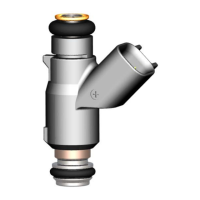Testing Recommendations and Precautions Multec 3.5 Fuel Injector Application Manual
8-2
Delphi Energy and Chassis Systems
Revision: 11/05-1
8.3 Dynamic Vehicle Testing
Dynamic Vehicle Testing is conducted at the vehicle assembly plant as a
quality assurance check that all vehicle systems are operating properly.
Typically, sensor output and engine performance are measured to verify
they are within expected limits as an indication of correct assembly. The
measured value acceptable range should be the same or greater than that
used during vehicle calibration. Any change in tolerance requirements
should be reviewed with the Delphi Application Engineer.
8.4 Standard Vehicle Development Tests
This section contains an overview of a number of recommended
development tests that should be conducted during the vehicle
development process to determine calibrations and or conformance to
requirements. This manual provides rough guidelines only, as procedures
vary from manufacturer to manufacturer.
8.4.1 Hot Fuel Handling
The purpose of hot fuel handling testing is to determine the effects of high
ambient temperature conditions on vehicle driveability and startability.
High temperatures increase the likelihood of fuel vaporization in the
injector and a resulting lean flow condition. (See section 2.2.7.2)
Tests typically consist of a prep of the vehicle by stabilizing temperatures
at highway speeds followed by soaks or extended idles and soaks. After
the soak, the vehicle is started and driven away, and the performance
compared to baseline results. Ambient temperatures should be at least 100
o
F (38
o
C), and the test should be done using high RVP fuel in the 11 to 14
PSI (76 – 97 kPa) range. (These parameters are selected based on the
customer’s application validation requirements.) Temperatures, pressures,
and engine control parameters should be recorded during testing to assure
consistency and for a record of results.
As a guideline for 12 psi (83 kPa) RVP non-oxygenated fuel, the
recommended maximum Multec 3.5 soak temperatures for acceptable hot
fuel handling are as follows. The injector tip temperature is measured as
shown in Figure 7-1:

